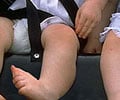A probe into King Tutankhamun's footwear has made experts to suggest that the boy king might have worn some sort of orthopaedic shoes specially designed to cope with his club foot condition.
A probe into King Tutankhamun's footwear has made experts to suggest that the boy king might have worn some sort of orthopaedic shoes specially designed to cope with his club foot condition.
The research is the first detailed analysis of the 3,300-year-old footwear since Howard Carter discovered King Tut's mummy and treasure-packed tomb in 1922.While the mummy had been X-rayed several times, it was only recently, during a major genetic investigation into King Tut's family, that researchers found a series of malformations in the pharaoh's feet.
Apart from a foot bone disorder known as Kohler disease II, the young king might have had seriously deformed feet, which left him hobbling around with the use of a cane.
It has been proven that the second toe in King Tut's right foot lacked the middle bone, making it shorter, while the left foot was clubbed, rotating internally at the ankle.
The foot condition might have required appropriate shoes with a tight strap in order to avoid them being dragged over the floor.
And three pairs of shoes found in King Tut's tomb actually have horizontal straps just below the toes.
Advertisement
"These features are not known in any other footwear, sandal or shoe alike," Discovery News quoted book author Andre Veldmeijer, a Dutch archaeologist who specializes in ancient Egyptian leatherwork, footwear and cordage, as saying in an exclusive interview.
Advertisement
However, others have survived in decent condition.
Veldmeijer studied 81 specimens, including simple sewn sandals as well as other elaborately decorated, gold ornamented, brightly coloured open shoes.
In collaboration with a German specialist in reproduction of ancient footwear, Veldmeijer is now testing the "orthopedic" shoe hypothesis by remaking King Tut's leather open shoes.
"We are collaborating with a professor in anatomy to see how deformed the foot was and how the shoes would have helped," said Veldmeijer.
The research has been published in the book, "Tutankhamun's Footwear: Studies of Ancient Egyptian Footwear."
Source-ANI
SRM











